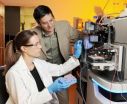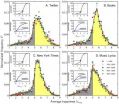Mass media and health: Well-informed people eat better
A study by Italian researchers shows that the more people are informed by newspapers, television and the Internet, the more they stick to the Mediterranean diet, the healthiest eating pattern in the world
2012-01-13
(Press-News.org) It is time to leave apart the belief that mass media are always a source of bad habits. Television, newspaper and the Internet, when used to get information, may turn out to be of help for health.
It is the conclusion of a study conducted by the Research Laboratories at the Fondazione di Ricerca e Cura "Giovanni Paolo II" in Campobasso which analyzed data from a sample of more than 1,000 people from the largest Moli-sani Project, the epidemiological study that recruited 25,000 subjects in Molise, a southern region of Italy.
The report, published on line in the International Journal of Public Health, is one of the first research considering the mass media information as a whole by taking into account the sources of information most used by people to get informed on several issues. So far scientists analyzed just the effects of television viewing on health, coming to negative conclusions.
"Scientific literature has mainly focused on television viewing, considered a risk factor for health mainly because it represents a measure of physical inactivity – says Marialaura Bonaccio, first author of the study and member of the Science communication unit at the Research Laboratories – Basically, watching TV is often linked to physical inactivity and snacking, with negative effects on obesity, a major cardiovascular risk factor. In our study we paid attention to the capacity of people to get informed by using mass media, including the Internet and newspapers or magazines. We sought to see whether most informed people had better eating habits than those less exposed to information".
Researchers from Campobasso conducted their study (called Moli-news) on more than 1,000 adult subjects randomly recruited from the general population. who participated to the epidemiological study Moli-sani. In addition to different information collected for the main project (medical information, lifestyle, dietary habits, etc) the participants to Moli-news also completed a specific questionnaire on mass media usage, from TV viewing to newspaper and magazine reading and surfing the Internet. Researchers had in the meantime created a score of mass media information exposure.
"Exposition to several media - explains Americo Bonanni, head of the Science communication unit of the Research Laboratories – has then been associated to lifestyle. We focused on eating habits, mainly on Mediterranean diet. Results have shown that people most exposed to information delivered by any mass media source, reported higher adherence to the Mediterranean-like eating patterns. The latter are considered as the most effective eating model for reducing the risk of chronic and neurodegenerative diseases. In particular, people resulting more informed reported higher consumption of some key foods of the Mediterranean diet pyramid, such as fruits and fresh fish, and a lower consumption of less healthy food such as animal fats".
"Information delivered by mass media – claims Giovanni de Gaetano director of the Research Laboratories – may appear fragmented or imprecise, especially when we talk about health and prevention. Our study has however provided data which may turn out to be very useful in a period in which to combat obesity increase, unhealthy dietary habits and diffused laziness we are urged to find new ways to communicate health. We should stop being suspicious of mass media. The next step will be to evaluate the single sources of information and to study the changes that the internet is introducing in the way people, mainly the youngest, get informed on health topics".
The Moli-sani Project is conducted by the Research Laboratories of the Fondazione di Ricerca e Cura "Giovanni Paolo II" in Campobasso, Italy. Started in March 2005, the study has recruited 25,000 citizens living in the Molise region, in order to investigate environmental and genetic factors responsible for cardiovascular disease and tumors. The Moli-sani study is changing the face of a whole Italian region by turning it into a large scientific laboratory.
INFORMATION: END
ELSE PRESS RELEASES FROM THIS DATE:
2012-01-13
Researchers from the Georgia Institute of Technology and the Centers for Disease Control and Prevention (CDC) have developed a new laboratory test that can rapidly identify the bacterium responsible for staph infections. This new test takes advantage of unique isotopic labeling combined with specific bacteriophage amplification to rapidly identify Staphylococcus aureus.
Quickly and accurately detecting infections caused by S. aureus is critical because the pathogenic bacterium causes a broad spectrum of infections, ranging from acute to chronic disease, which need to ...
2012-01-13
Physicists at Linköping University have shown that a dose of hydrogen or helium can render the "super material" graphene even more useful.
Graphene has engendered high expectations whereof its extreme properties depend on the fact that it consists of a single sheet of carbon atoms. However the attraction forces between the atoms cause the sheets to be drawn to each other. One solution is to add atomic hydrogen between the layers.
Presented in the eminent journal Physical Review A, the researchers' calculations show that the hydrogen at a given concentration affects ...
2012-01-13
Thousands more American senior citizens with kidney disease are good candidates for transplants and could get them if physicians would get past outdated medical biases and put them on transplant waiting lists, according to a new study by Johns Hopkins researchers.
The Hopkins investigators estimate that between 1999 and 2006, roughly 9,000 adults over 65 would have been "excellent" transplant candidates and approximately 40,000 more older adults would have been "good" candidates for new kidneys. None, however, were given the chance.
"Doctors routinely believe and tell ...
2012-01-13
New Orleans, LA – A study led by Russell R. Russo, MD, a third-year Orthopaedic Surgery resident at LSU Health Sciences Center New Orleans School of Medicine, has identified a new source of life-threatening necrotizing fasciitis – "bath salts." The study, describing the first known case of necrotizing fasciitis from an intramuscular injection of the street drug known as "bath salts," is published in the January 2012 issue of Orthopedics, now available online.
Necrotizing fasciitis is an orthopedic emergency. The ability to quickly and accurately diagnose this rapidly ...
2012-01-13
TORONTO, Ont., Jan. 12, 2012—Researchers at St. Michael's Hospital have published the first detailed figures showing the risk of using the prescription drug Rasilez in combination with certain other blood pressure-lowering medications.
The pharmaceutical company Novartis terminated a large, international clinical trial of the drug last month after finding an increased incidence after 18-24 months of non-fatal strokes, renal complications, high levels of potassium in the blood and low blood pressure.
As a result, Health Canada said on Dec. 22 that it would review the ...
2012-01-13
A new study published in the journal Nature Medicine by NYU Cancer Institute researchers, shows how the cancer causing gene Notch, in combination with a mutated Polycomb Repressive Complex 2 (PRC2) protein complex, work together to cause T- cell acute lymphoblastic leukemia (T-ALL).
T-ALL is an aggressive blood cancer, predominately diagnosed in children. It occurs when one lymphoblast, an immature white blood cell, turns malignant, multiplying uncontrollably and spreading rapidly throughout the body. If left untreated, the disease can be fatal in a few weeks. Cancer-causing ...
2012-01-13
WEST LAFAYETTE, Ind. - Honeybee populations have been in serious decline for years, and Purdue University scientists may have identified one of the factors that cause bee deaths around agricultural fields.
Analyses of bees found dead in and around hives from several apiaries over two years in Indiana showed the presence of neonicotinoid insecticides, which are commonly used to coat corn and soybean seeds before planting. The research showed that those insecticides were present at high concentrations in waste talc that is exhausted from farm machinery during planting.
The ...
2012-01-13
"If it bleeds, it leads," goes the cynical saying with television and newspaper editors. In other words, most news is bad news and the worst news gets the big story on the front page.
So one might expect the New York Times to contain, on average, more negative and unhappy types of words — like "war," " funeral," "cancer," "murder" — than positive, happy ones — like "love," "peace" and "hero."
Or take Twitter. A popular image of what people tweet about may contain a lot of complaints about bad days, worse coffee, busted relationships and lousy sitcoms. Again, it might ...
2012-01-13
TAMPA, Fla. (Jan. 12, 2012) – Using two cell surface markers found to be highly expressed in breast cancer lymph node metastases, researchers at Moffitt Cancer Center, working with colleagues at other institutions, have developed targeted, fluorescent molecular imaging probes that can non-invasively detect breast cancer lymph node metastases. The new procedure could spare breast cancer patients invasive and unreliable sentinel lymph node (SLN) biopsies and surgery-associated negative side effects.
Their study was published in a recent issue of Clinical Cancer Research ...
2012-01-13
For years, researchers seeking new therapies for traumatic brain injury have been tantalized by the results of animal experiments with stem cells. In numerous studies, stem cell implantation has substantially improved brain function in experimental animals with brain trauma. But just how these improvements occur has remained a mystery.
Now, an important part of this puzzle has been pieced together by researchers at the University of Texas Medical Branch at Galveston. In experiments with both laboratory rats and an apparatus that enabled them to simulate the impact of ...
LAST 30 PRESS RELEASES:
[Press-News.org] Mass media and health: Well-informed people eat better
A study by Italian researchers shows that the more people are informed by newspapers, television and the Internet, the more they stick to the Mediterranean diet, the healthiest eating pattern in the world

